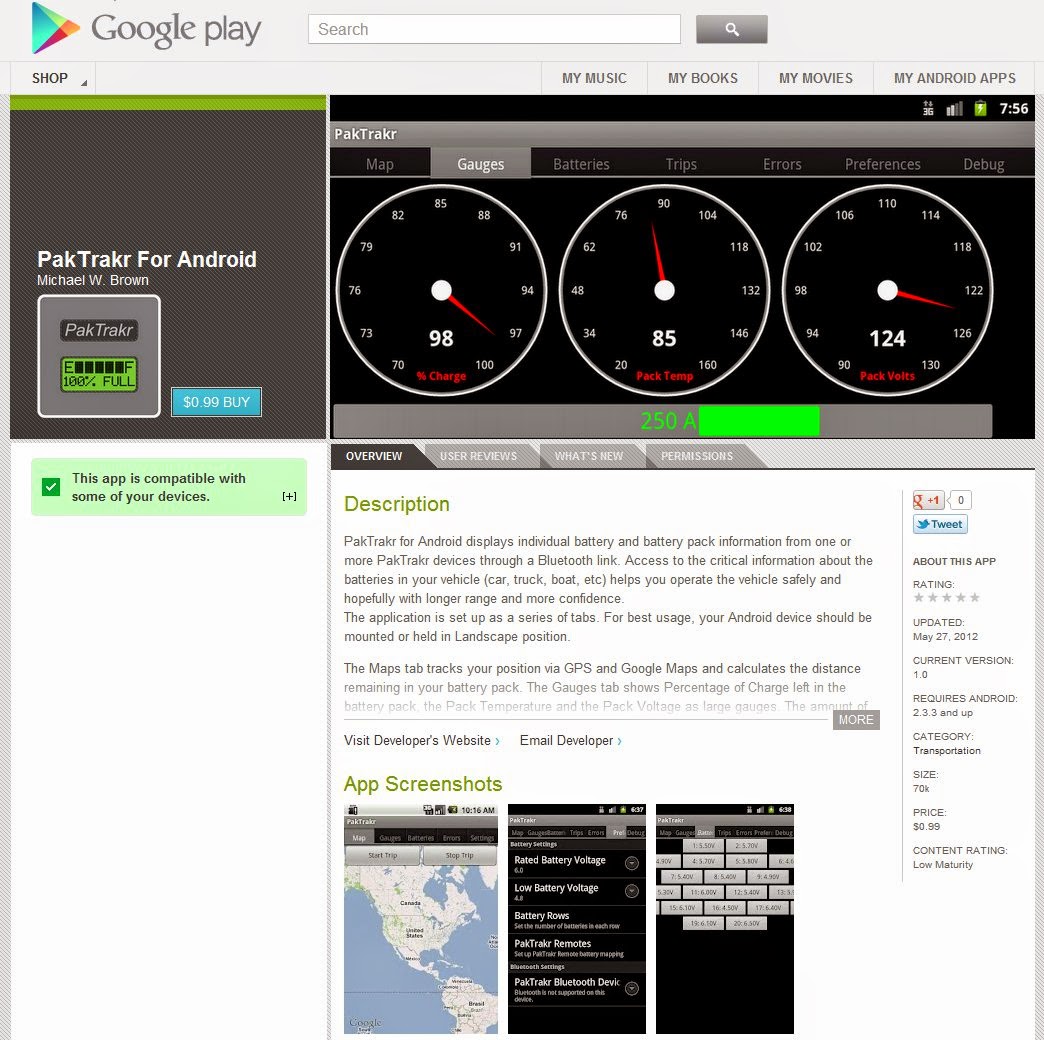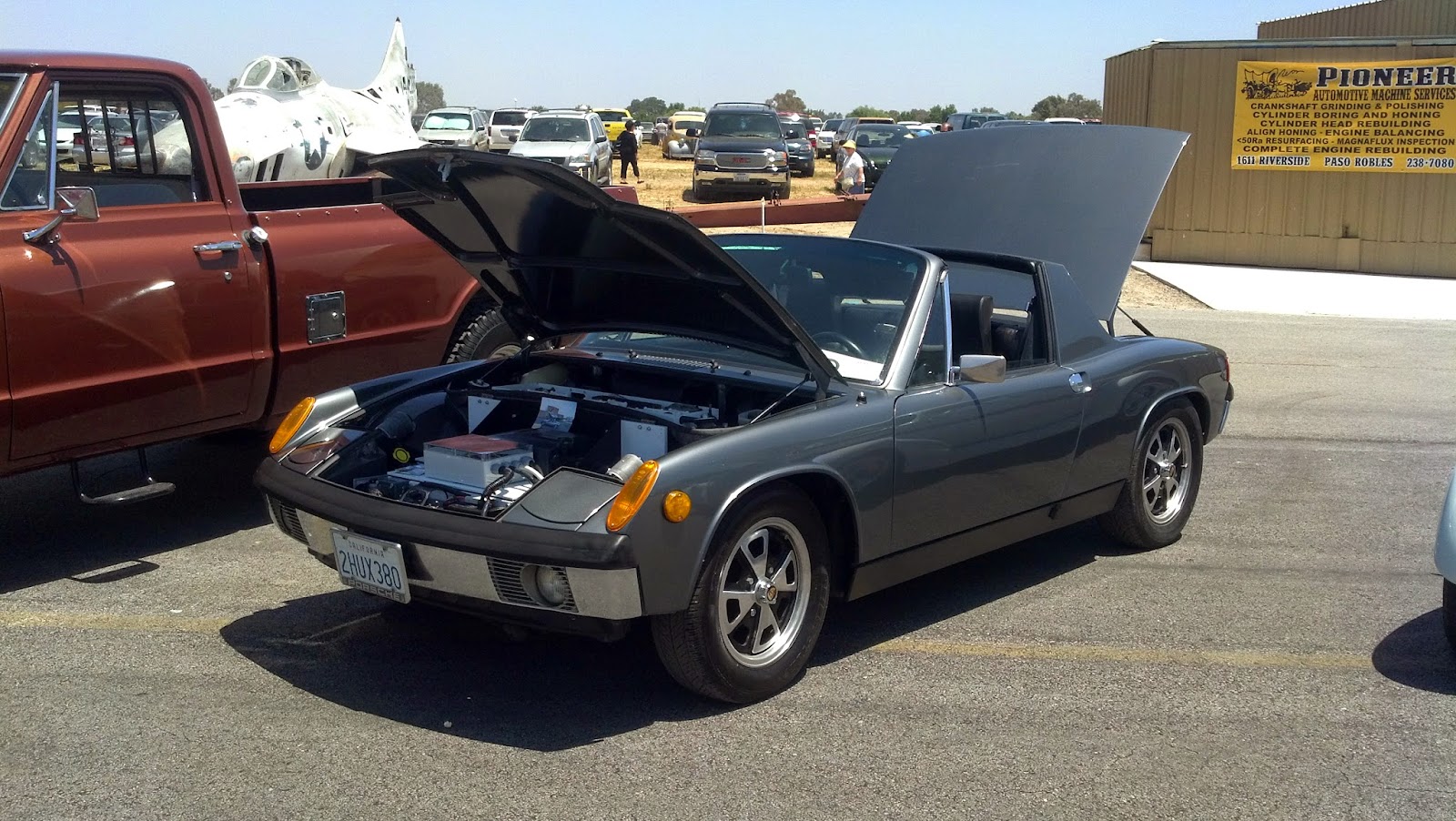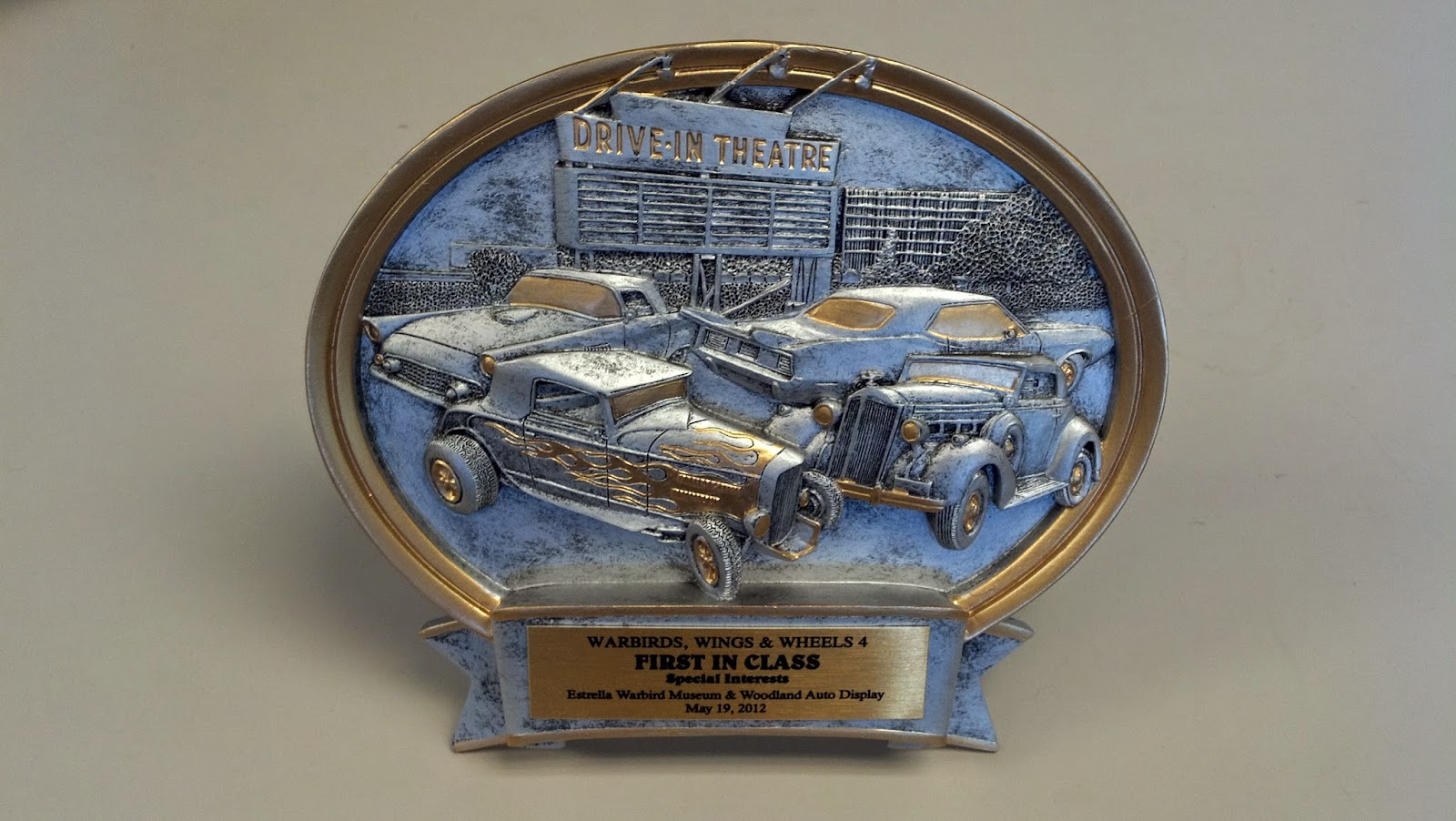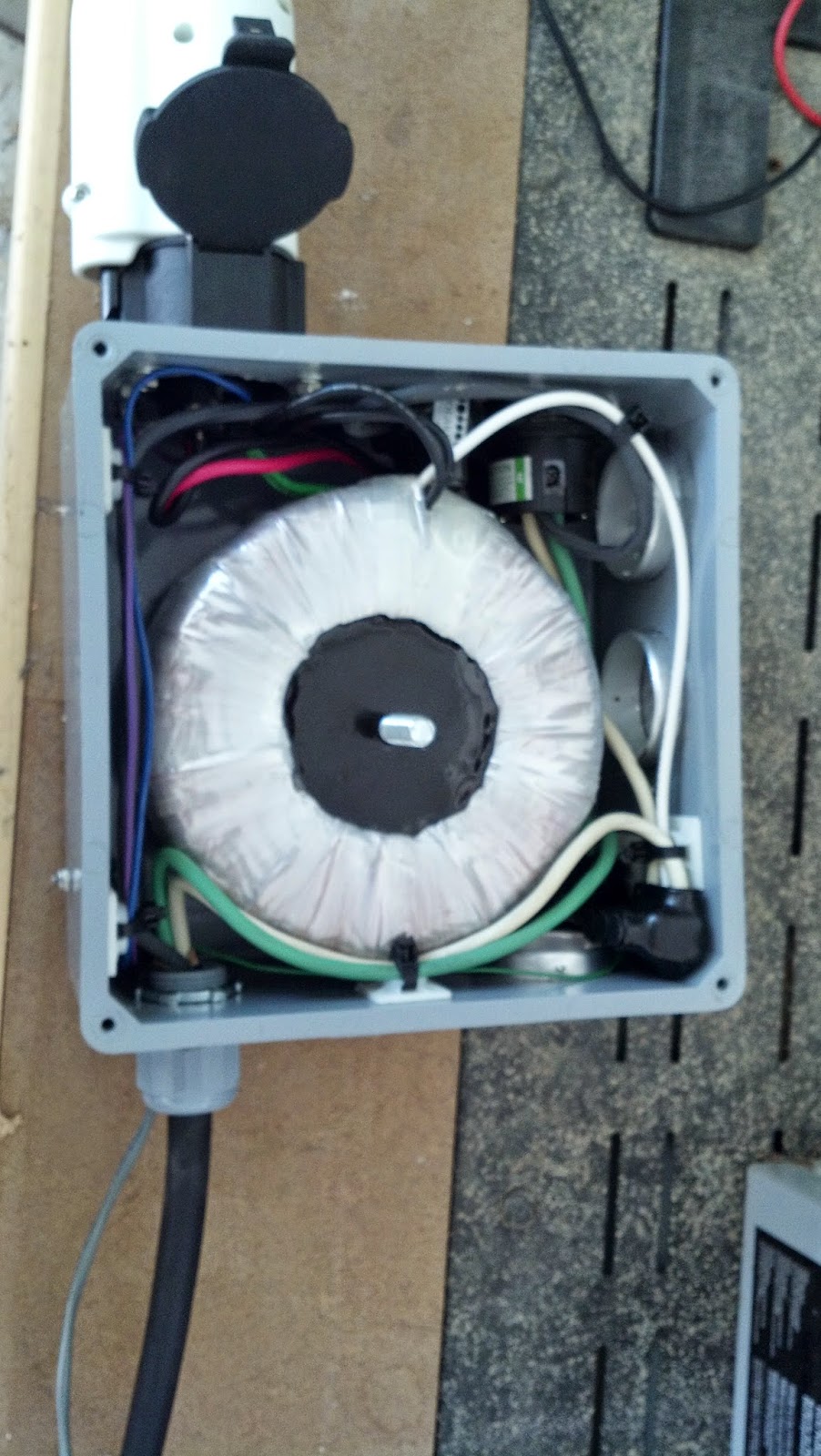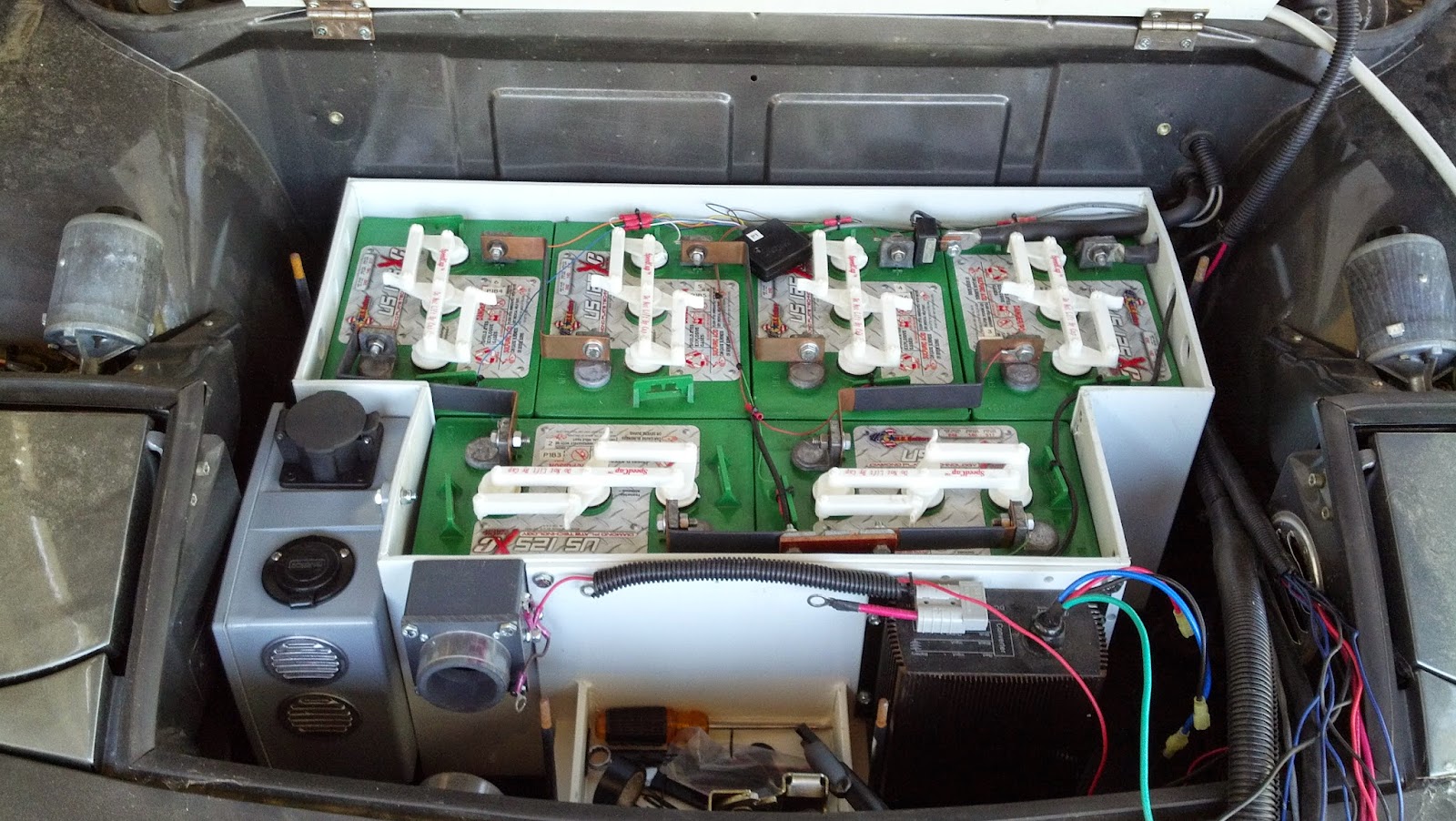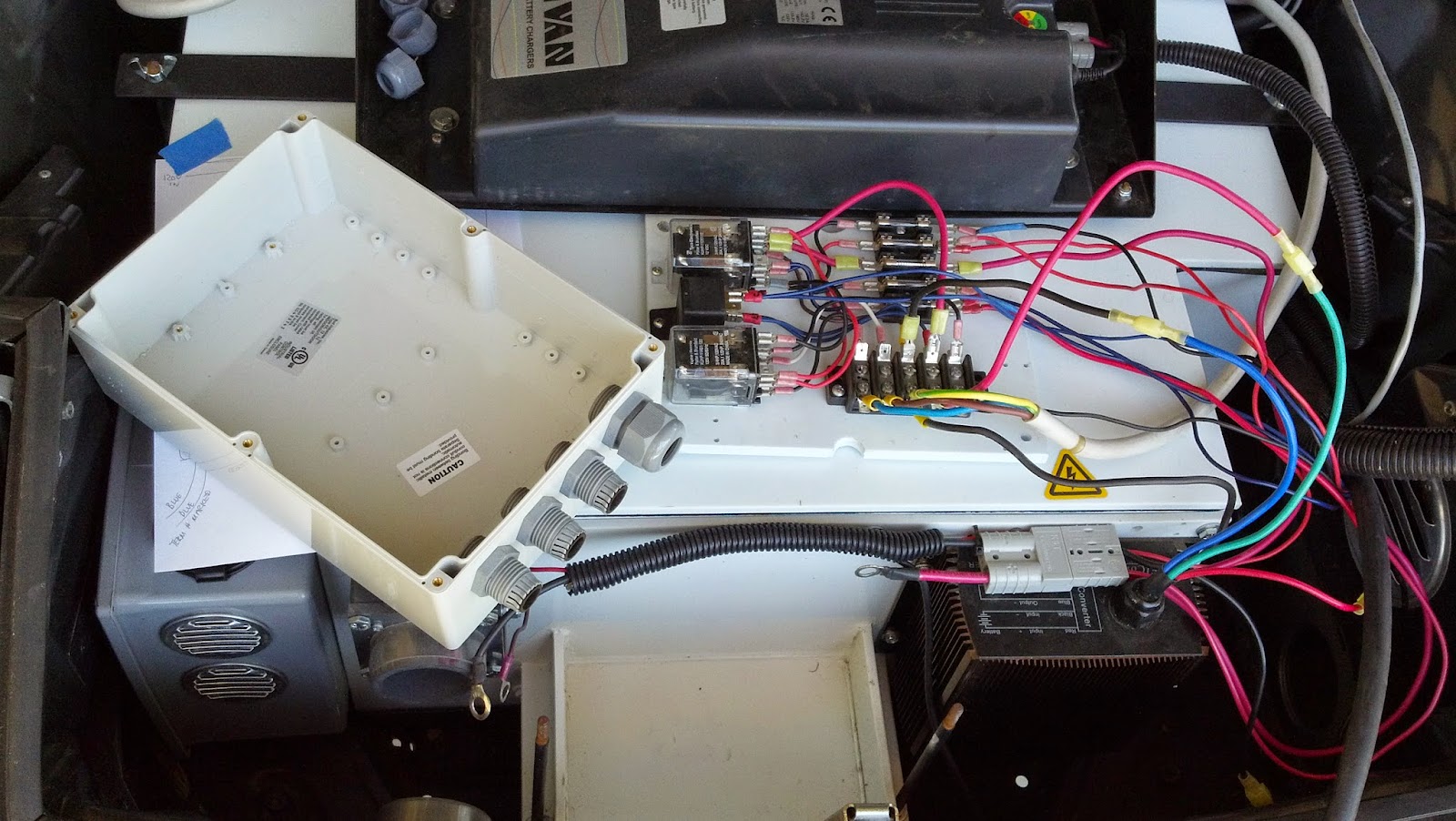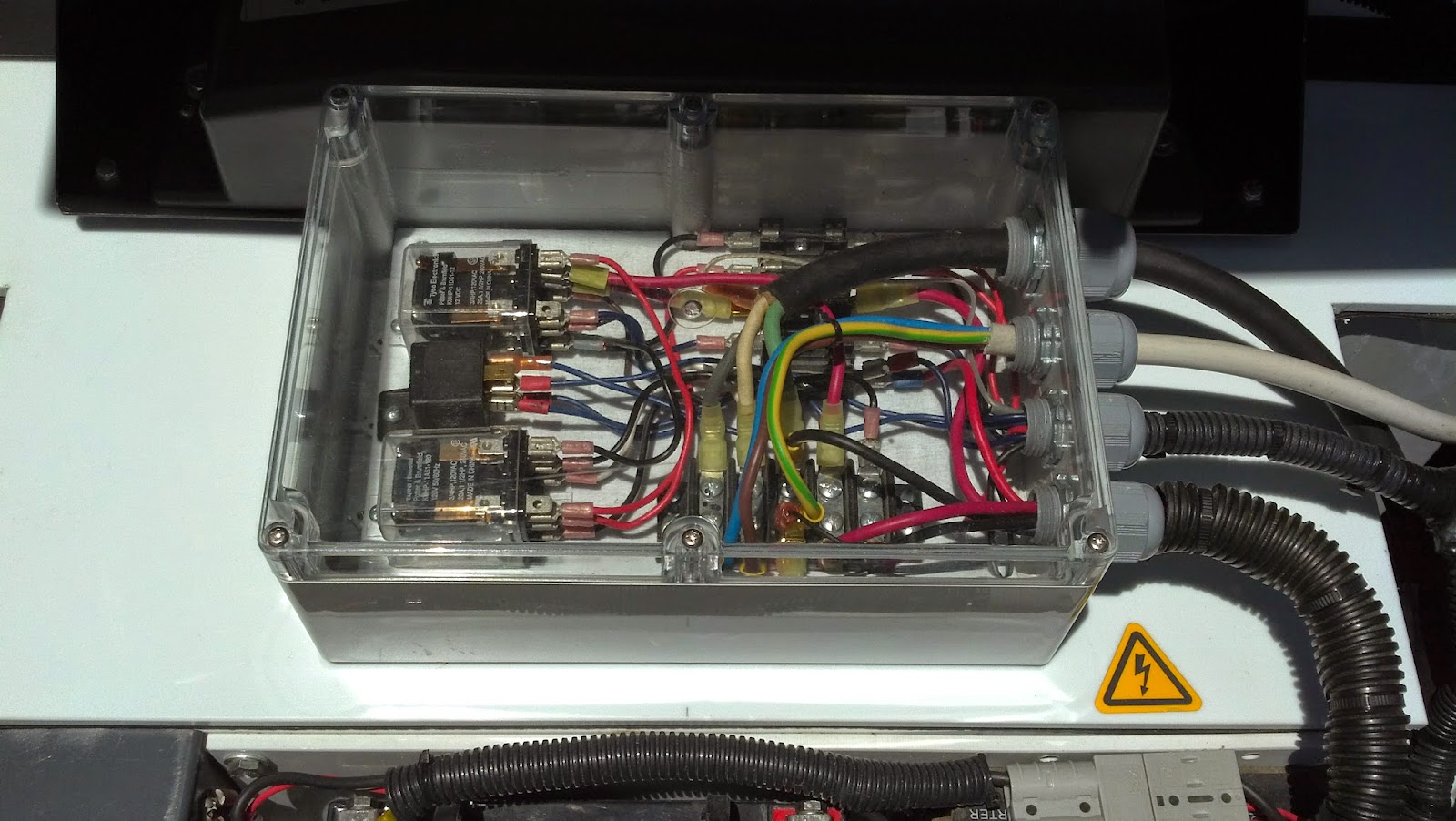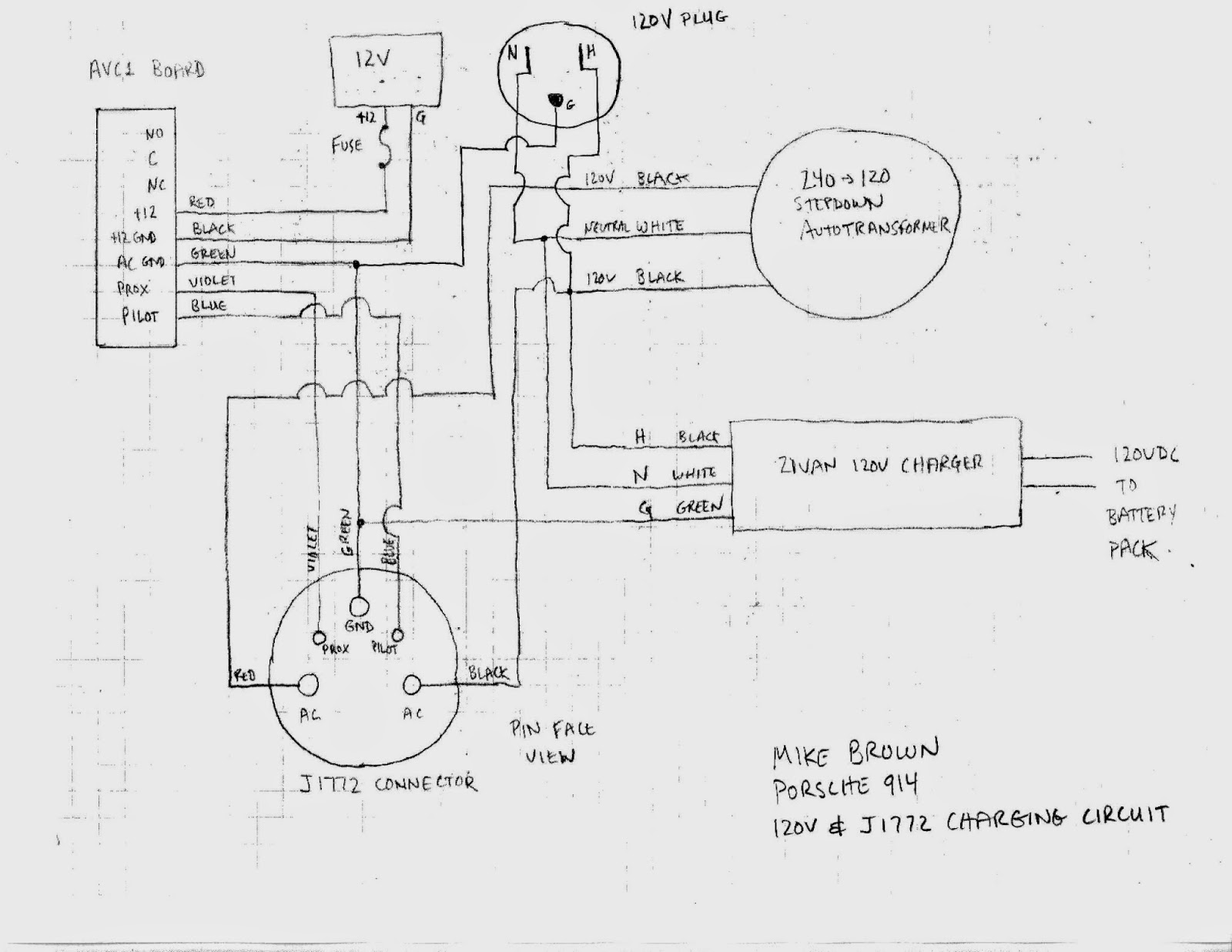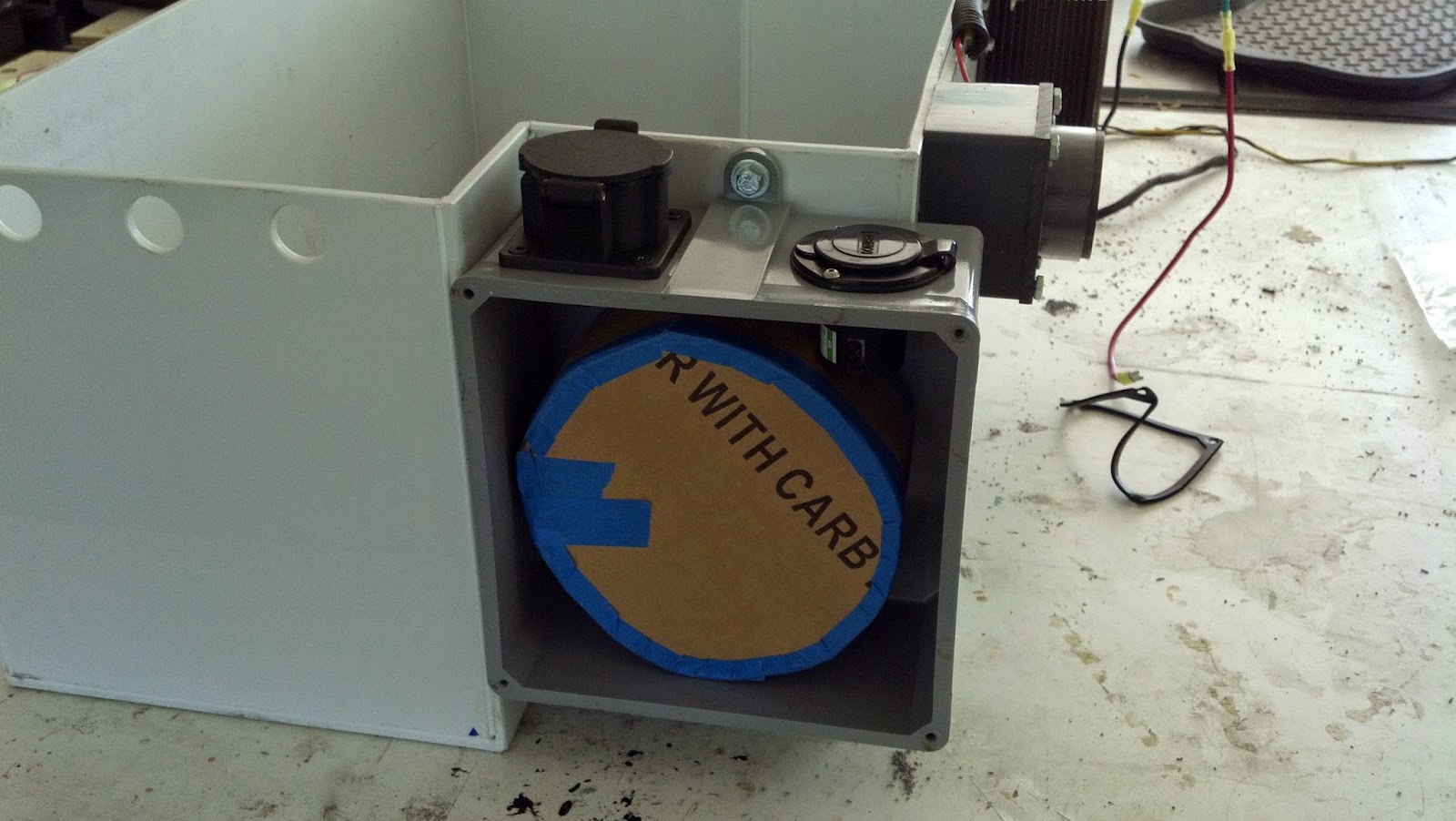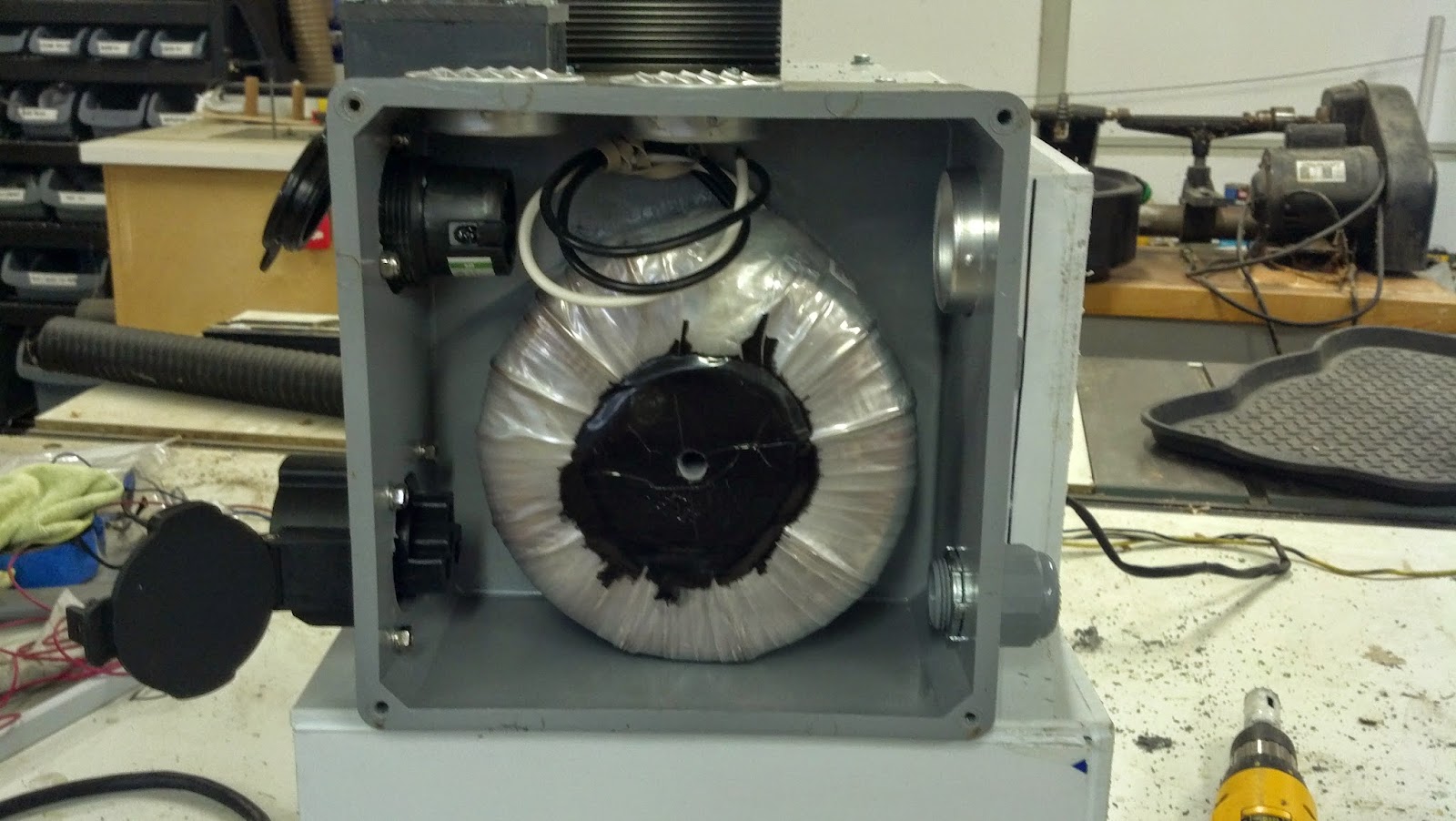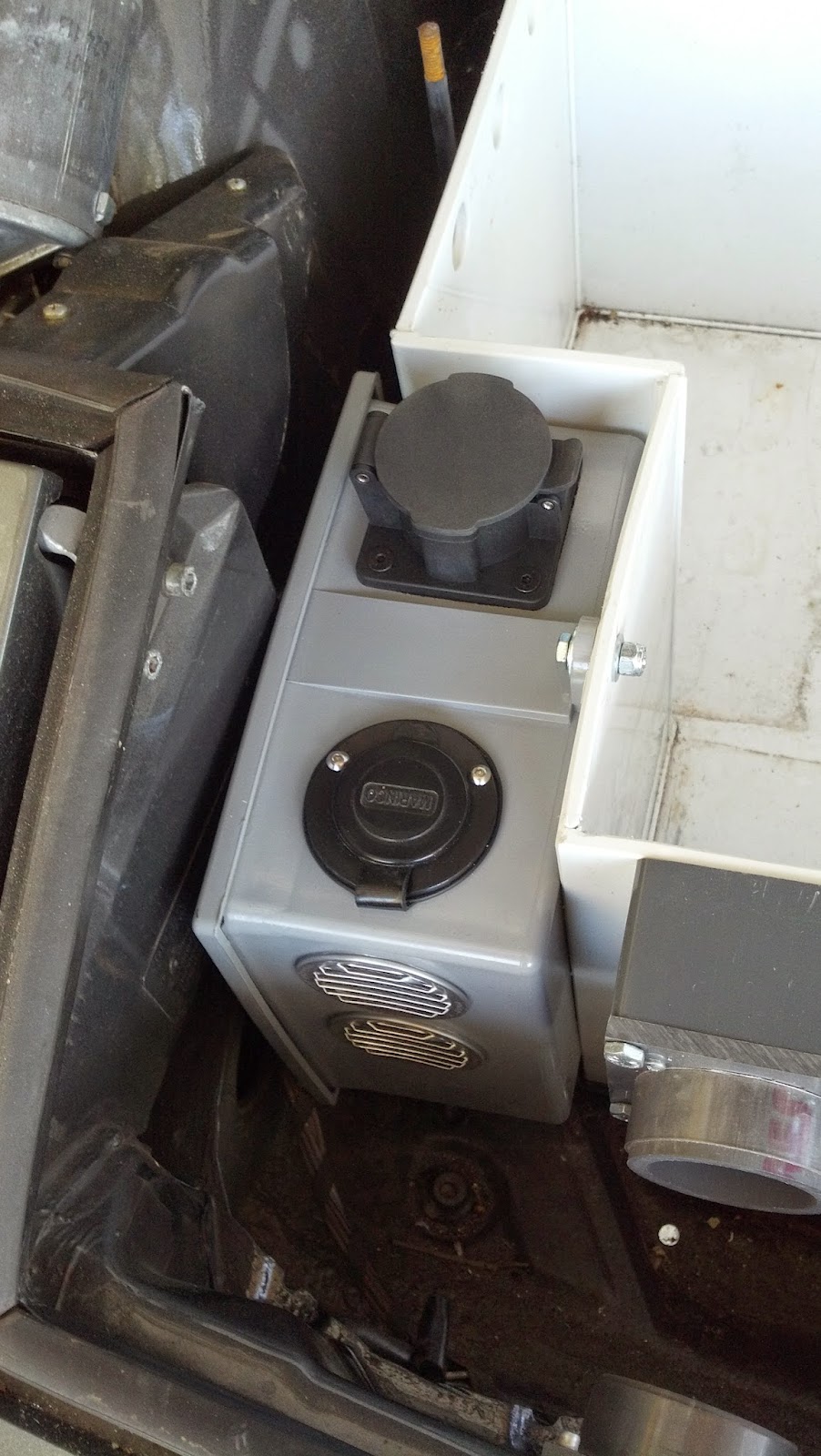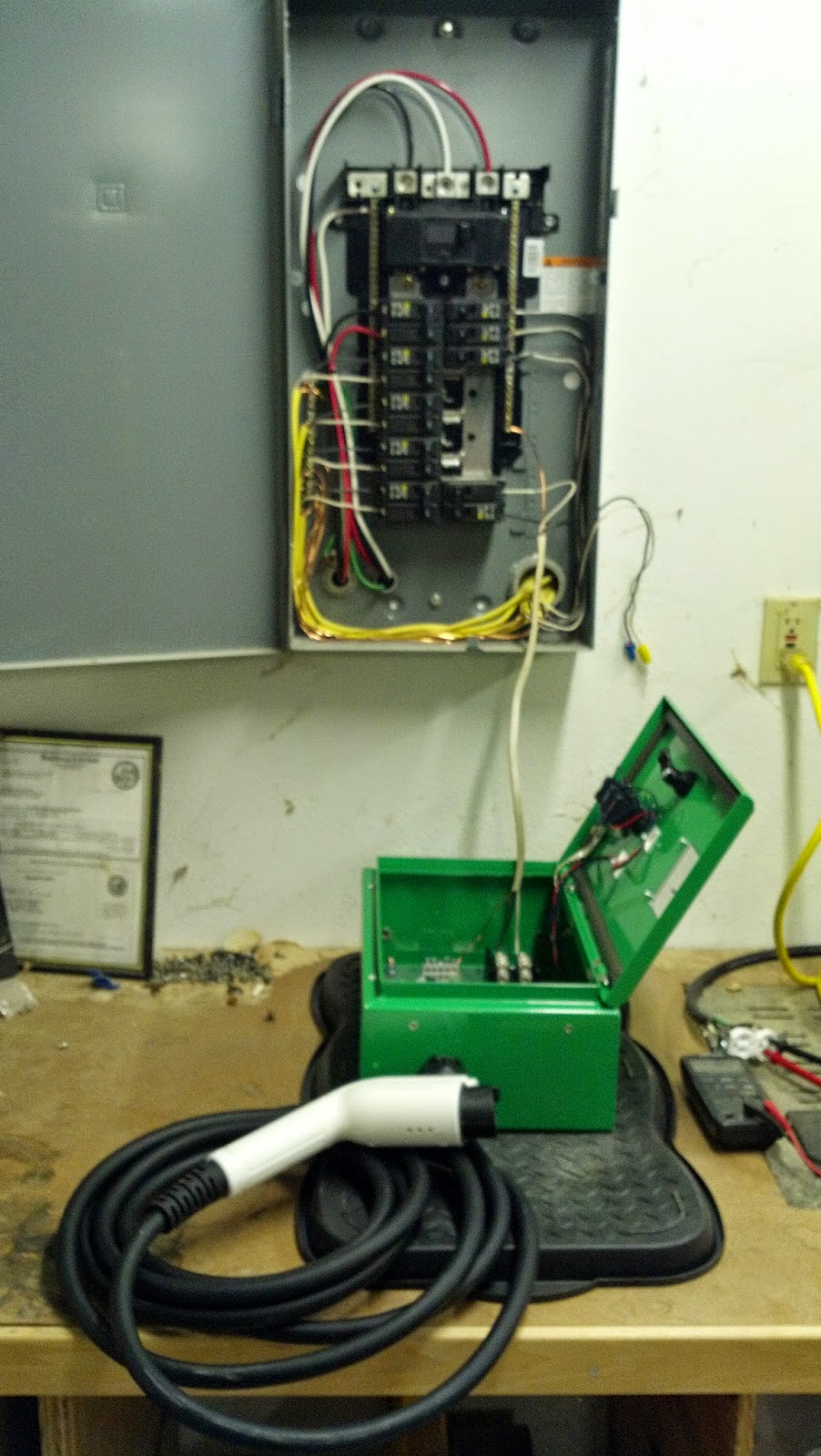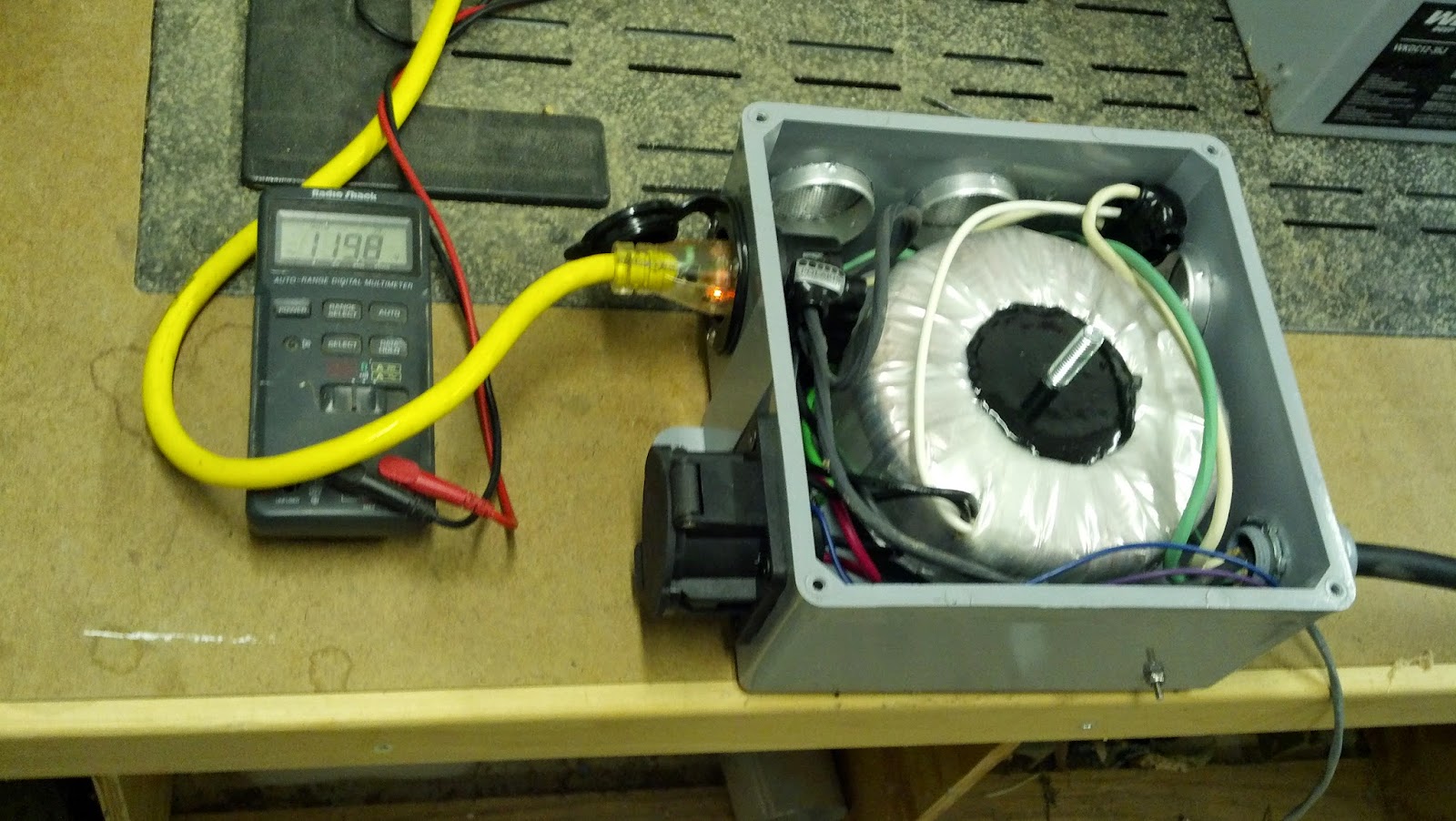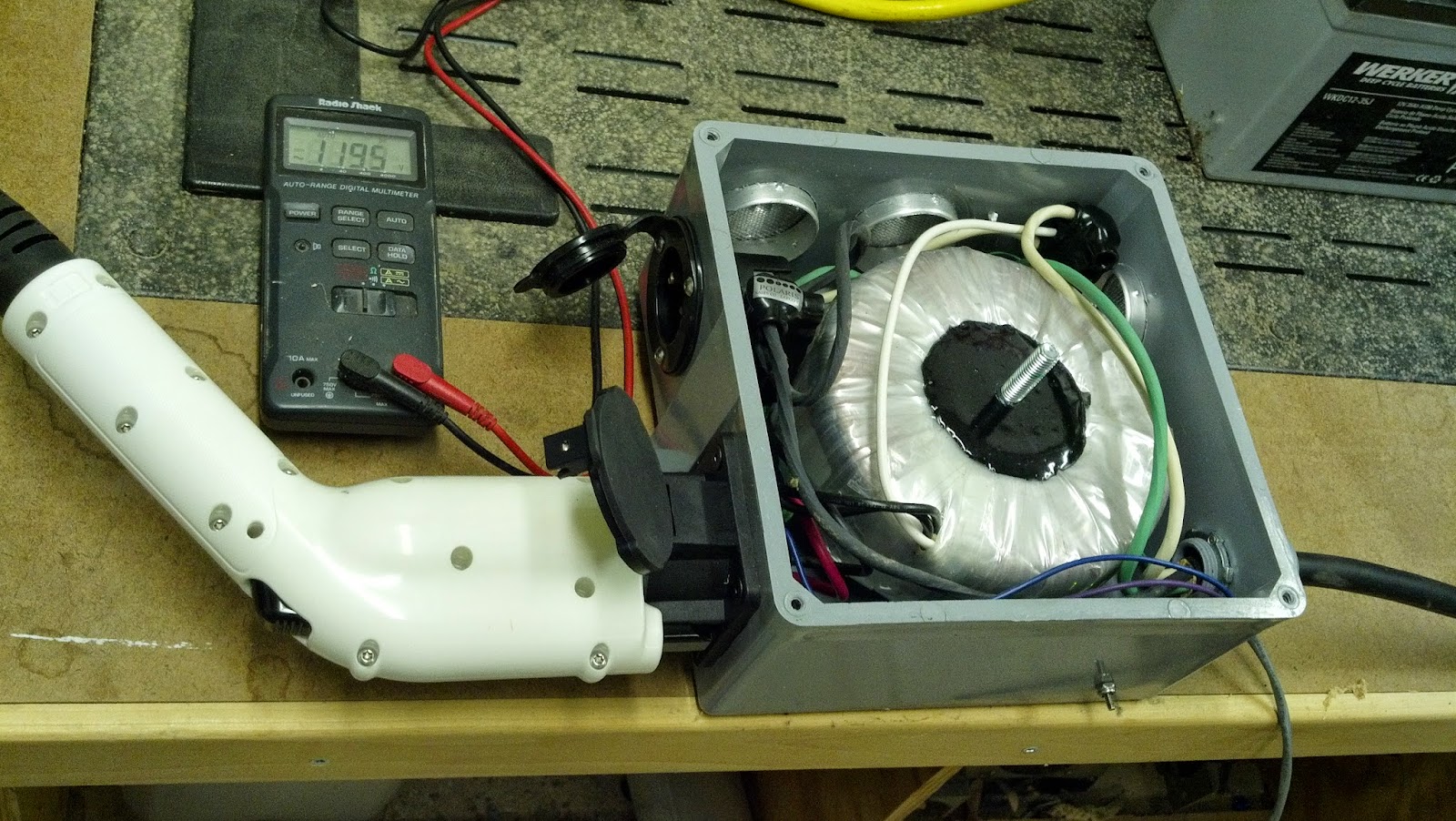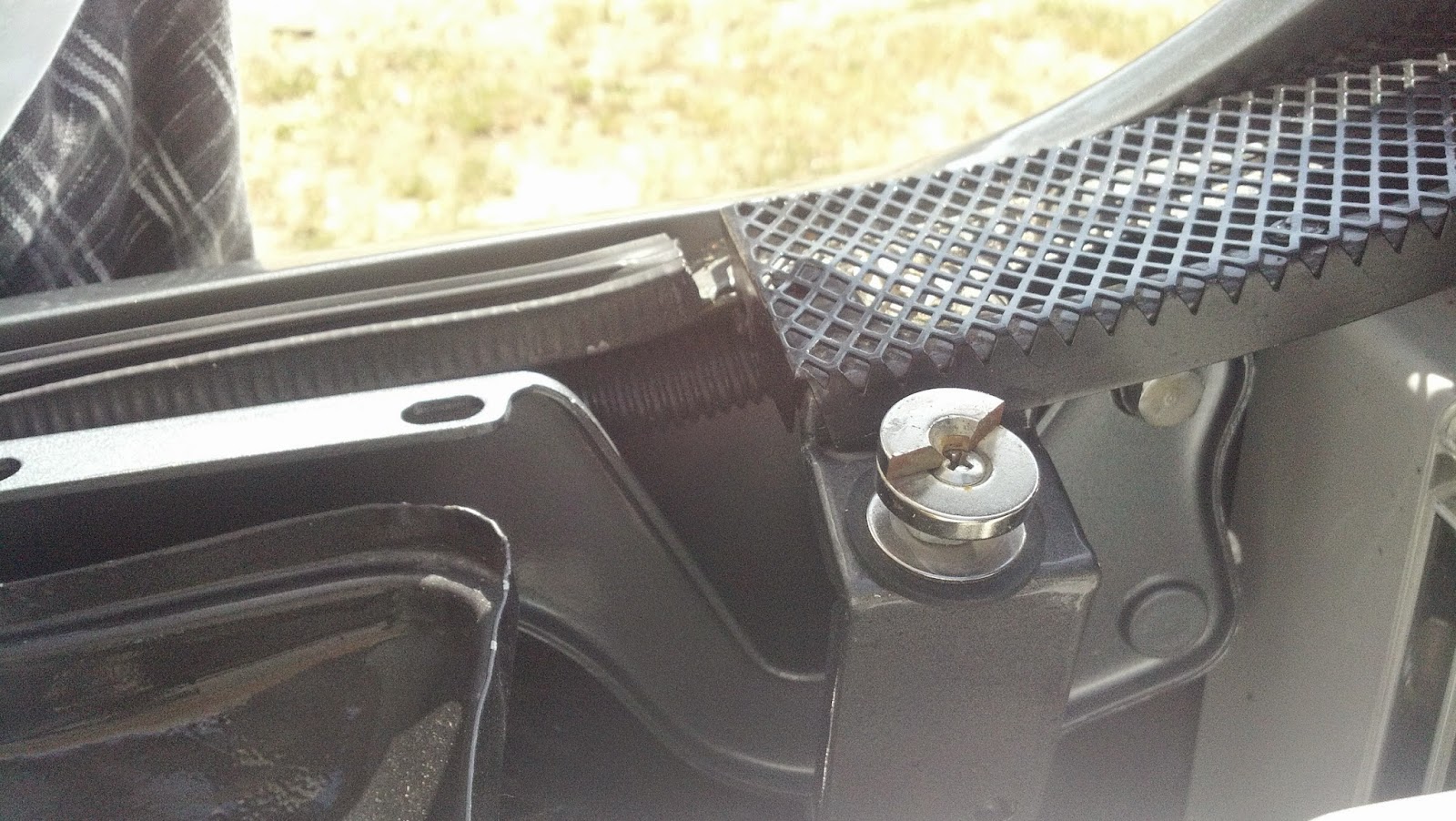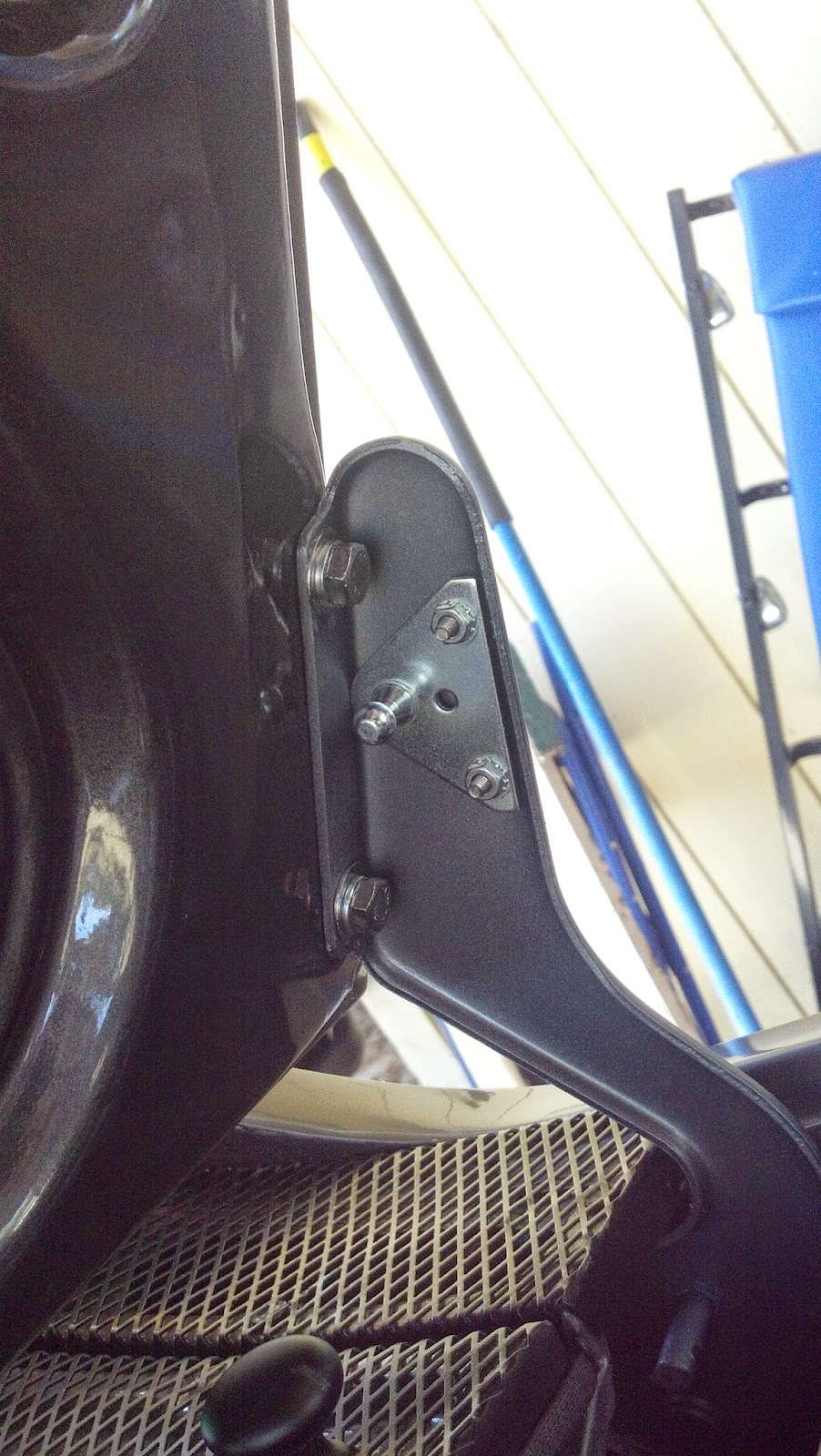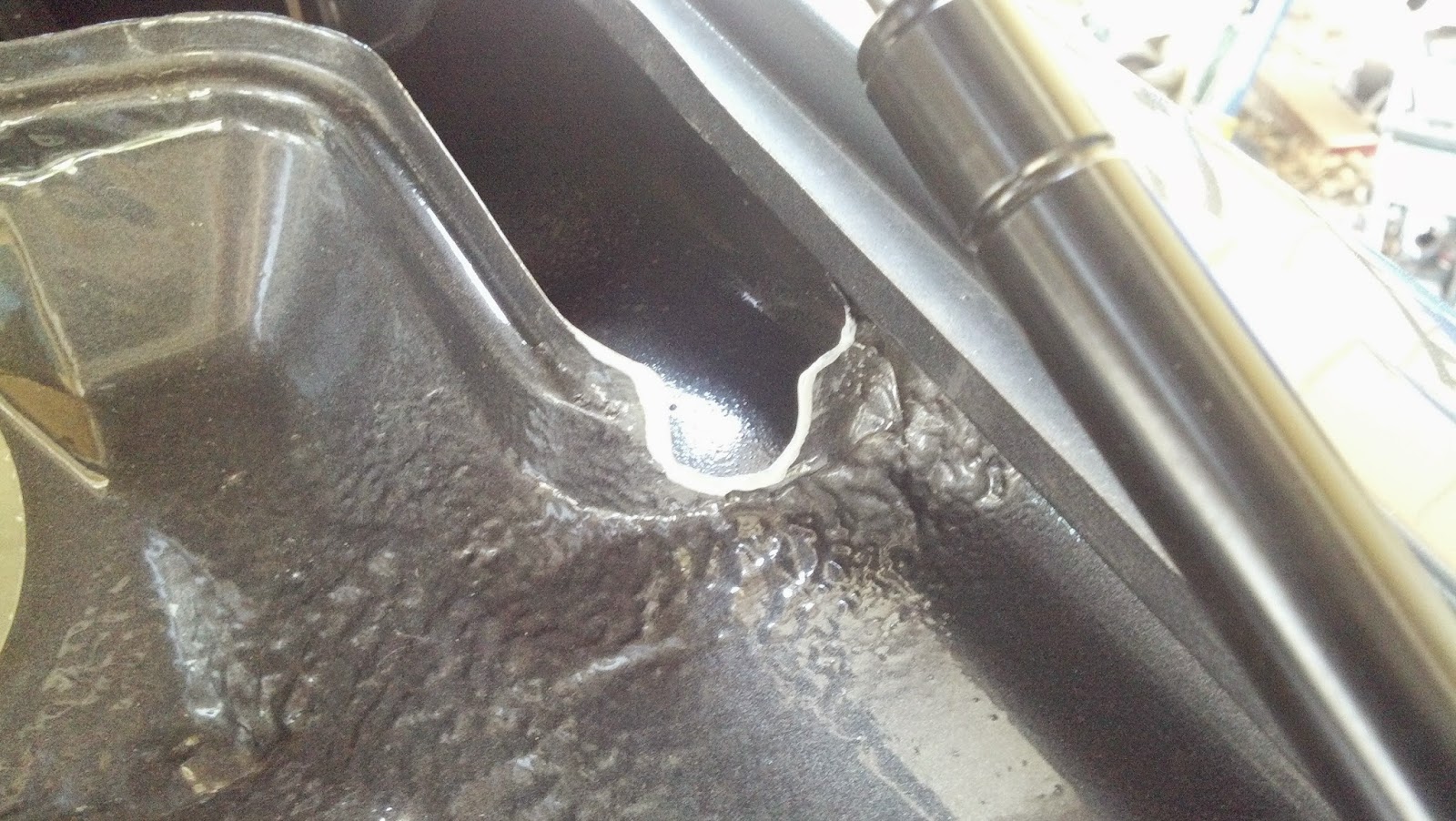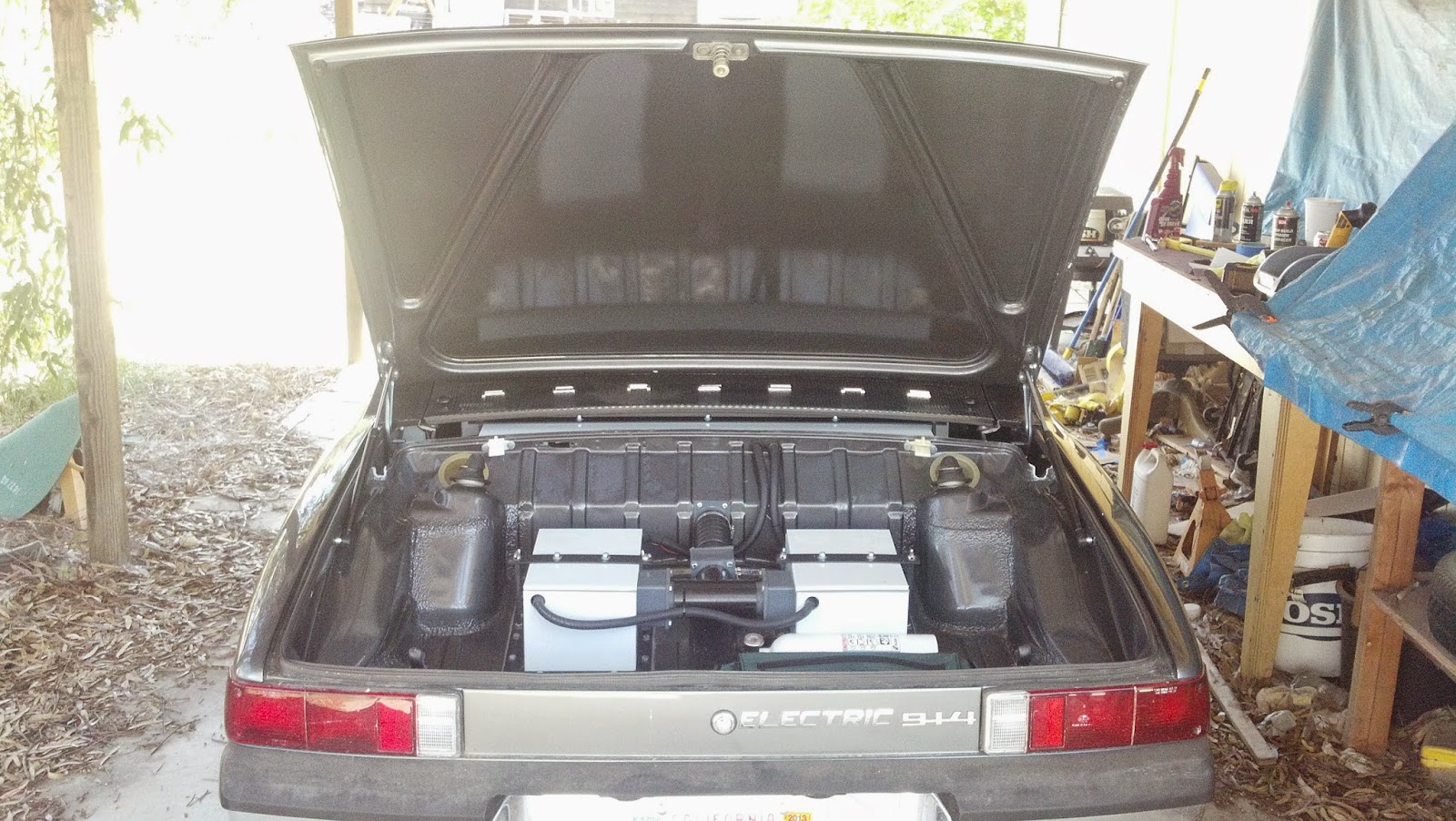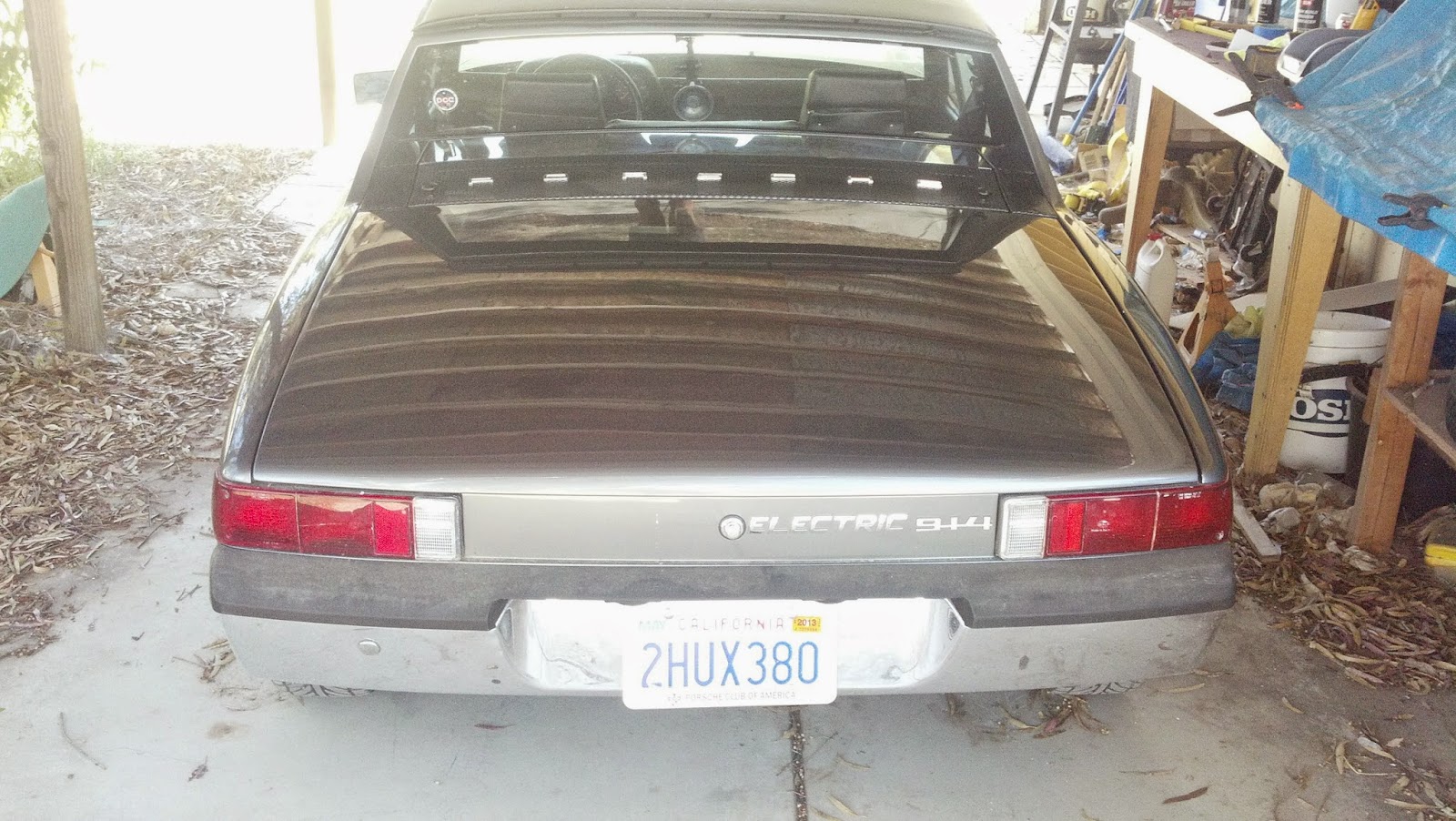Alert readers will recall that I was having doubts about the effectiveness of my charger. I was alarmed to see it was driving my 120V DC battery pack at 153V DC, when the sticker said it should be 143V DC!
After I called the Zivan repair service and described what I was seeing, they told me to send it in for testing. After they ran it on the bench, I got a call from Mark, saying it was fine. Here's what he said, any errors or omissions are mine. I've been learning about the mysteries of battery packs on the streets and shady blogs, so I was happy to have another data point.
Mark said that the pack should be overcharged. Specifically my pack should be charged aggressively up to 157V with the T-125 battery setting "4" on the rotary switch. If I'm concerned about charging it too hard, I can set the switch to "3" which offers a slightly gentler charge for T-105 type batteries. After 12-18 months the batteries should be mature and I can switch back up to "4" and drive them a little harder. 110% - 115% overcharge is OK.
The lower-voltage cells have to be allowed to charge up to the level of the higher-voltage batteries. This is what Jack Rickard calls a "top balancing" scheme, which he says is wrong for lithium batteries, but he doesn't believe in lead-acid so it may be valid.
For the charging-state LED, a fairly-long yellow is OK, which represents the 80% to 100% stage. I thought it should be much shorter, adding to my distress over the observed voltage.
Now having explained all this, I still have exactly the same symptoms that another person at Zivan diagnosed the charger as faulty and I should send it in. This exercise cost me $70 plus shipping with nothing to show for it but a little more knowledge.
After I redid the whole charging system with the J1772 connector wired in, I did a short 3 hour charge and took it to the car show. I noticed that the performance was rather sluggish, but the voltage was right about 120V DC and the PakTrakr state of charge was 100%. Yesterday I decided to trust the charger and let it go through the full cycle without panicking and pulling the cord. Well imagine my surprise when it put 13.11 KWH into the pack over the course of 10:33. I had been doing about 8 KWH over 6 hours previously. The voltage peaked at 153.3V DC and dropped down to 132.2V DC shortly after disconnecting the charger.
13.11 KWH is far beyond what I calculated for the 80% to 100% charge capacity, so I'm hoping that the pack was just very thirsty because I hadn't been charging it all the way up. I did a short drive around the back yard today and the acceleration was neck-snapping like I remember from my first drive. I hope I haven't damaged the pack. If you know me, you know I'm a bit of a pessimist and I have this sinking feeling in the back of my mind that I now own a 10 mile pack. Well, I'll do some range testing and see how it looks. I just don't have the spare cash for a lithium pack so I'll have to make this work for as long as I can.
This blog follows the progress of restoring and converting a 1973 Porsche 914 from stock to full electric drive, with an electric motor and half a ton of batteries. Now that the car is done and in storage while I live overseas, I'm adding descriptions and pictures of each Tesla location I visit.
Sunday, May 27, 2012
PakTrakr For Android Published to Google Play Store
Well I followed the 97 (it seemed like) step process to prepare the PakTrakr For Android app to be published in the Google Play store. I made extensive notes so I won't have to re-learn everything for version 1.1. After a few hours of Google magic processing, it showed up. You can find it if you search for PakTrakr. Here's a screen shot of how it looks in the store. Google does a nice job presenting the app with the screen captures I made, and making it easy to click away 99 hard-earned cents! I was going to make this initial release free as we work through any bugs and enhancements, but if you make it free from the start, you can't make it a pay-app in the future. Others have worked around this by having a fully-featured pay app and a cut-down free app. As a user, I don't think there's anything that I would want to have removed so I decided against the free version.
The "manual" for the app will always be here, so check for the latest updates.
The "manual" for the app will always be here, so check for the latest updates.
Tuesday, May 22, 2012
Warbirds, Wings, Wheels and Major Awards
Well it's not the glow of electric sex in the front window like Raphie's father got, but this weekend I picked up a major award myself - the First In Class trophy for "Special Interests" at the Warbirds, Wings and Wheels 4 car show in Paso Robles, California.
Here she is, hoods up and targa top off in all her Teutonic electric glory. I must have talked with over 100 people about the car and electric cars in general. I got some nice comments about the build quality, something I spent an inordinate amount of time on. I also dispelled some rumors about the Chevy Volt fire, range anxiety, electric vehicle cost, last week's Fisker fire, Tesla's imminent release of the Model S, Communists and Socialists... About a dozen people remembered the car from the Warbirds show last year as an empty shell, with my promise of having it built and running by next year's show. I don't think any of them thought I was going to pull it off, and frankly at times neither did I!
They had me lined up directly across from Corvette Row, which was ironic given the amount of gas they burn.
The organizers were expecting up to 500 cars to show up. I didn't get much time to walk around but there were cars as far as they eye could see.
At the end of my row was this Iwo Jima-experienced P-51 Mustang, named Dolly.
And here's my major award, a 3D image of a classic American icon - hod rods at a Drive In theater on a Saturday night. Well my little electric 914 is not quite in line with the image, but the judges seemed happy to have me and I was happy to be there. Next up, the Gathering Of Friends VI all European car show at Laguna Lake in San Luis Obispo on July 15.
Here she is, hoods up and targa top off in all her Teutonic electric glory. I must have talked with over 100 people about the car and electric cars in general. I got some nice comments about the build quality, something I spent an inordinate amount of time on. I also dispelled some rumors about the Chevy Volt fire, range anxiety, electric vehicle cost, last week's Fisker fire, Tesla's imminent release of the Model S, Communists and Socialists... About a dozen people remembered the car from the Warbirds show last year as an empty shell, with my promise of having it built and running by next year's show. I don't think any of them thought I was going to pull it off, and frankly at times neither did I!
They had me lined up directly across from Corvette Row, which was ironic given the amount of gas they burn.
With a jet fighter of some kind pointed right at me.
The organizers were expecting up to 500 cars to show up. I didn't get much time to walk around but there were cars as far as they eye could see.
At the end of my row was this Iwo Jima-experienced P-51 Mustang, named Dolly.
And here's my major award, a 3D image of a classic American icon - hod rods at a Drive In theater on a Saturday night. Well my little electric 914 is not quite in line with the image, but the judges seemed happy to have me and I was happy to be there. Next up, the Gathering Of Friends VI all European car show at Laguna Lake in San Luis Obispo on July 15.
Sunday, May 13, 2012
J1772 Charging - The Joy and the Agony
I continued with the work on the J1772 upgrade from yesterday. Here I've tidied the wiring and zip-tied the wires in place.
I painted the gray epoxy repair holding the front battery in place with white plastic paint.
The box is now mounted to the side of the battery box. You can see the nut holding the transformer bolt into place. This will cause me some anguish shortly, I should have seen it coming...
Finally the battery box is back in and the batteries are dropped into place.
The batteries are wired up and the PakTrakr leads are all re-installed.
I did another 120V and J1772 test, both passed! Note that I didn't tie the box's 120V output into the charger yet, so there's no load on the output.
Since the initial side-mounting for the relay box was inaccessible, I decided to mount it right on the top of the front battery box cover. This will give me easy access to the fuses and the wiring. I got another PVC enclosure and put the cable glands on the right side. I attached heavy strength Velcro to the bottom, so if I need to get to the batteries, I pull the box off the Velcro and move it to the right side. Now I just have to move the redo all of the wiring.
And here is the final result! This is now the overall front trunk layout. Dual charging plugs are on the left, control circuitry in the middle in a NEMA-rated enclosure, and a twist-apart AC disconnect on the right side.
Here's a close-up of the control circuitry. Moving it to this position makes it far easier to check for blown fuses and future upgrades.
After the wiring was complete, I plugged in for yet another charger test. Note that this was the first one with the load of the charger filling the battery pack. After a few seconds, I saw smoke coming out of the J1772 box! Fudge bucket!
That led to an adventure of getting the J1772 box out. I had two problems that I should have recognized during the design.
First, the bottom bolt is mostly inaccessible - I could touch it with my fingers, but couldn't get a wrench on it. I ended up taking out the battery adjacent to the J1772 box and drilling out the bottom bolt from inside the battery box. I won't replace the bottom bolt because it's not necessary for holding the box in place.
Second, the big nut on the outside of the cover on the transformer bolt is about 1/4" too long and the side of the headlight area was blocking the box sliding up. I managed to get a ratcheting socket on the nut and got it off, but the bolt was still too long. After a lot of swearing, I drilled a 1" hole through the wall of the battery box where the head of the transformer bolt is. I then backed out the bolt through the hole. The J1772 box then lifted right up.
My guess was that I had botched the wiring on the AVC1 board and melted it, but when I opened it up, I found the board seemed to be in good shape, but the small wire I used for ground was crispy where the insulation used to be.
I sent an email to David Kerzel of Modular EV Power at 7:00 PM on a Sunday night hoping for a reply sometime tomorrow but he wrote back in 30 minutes! He asked some questions about the wiring, so I've sent him my schematic and we're going back and forth on the problem. Great customer service!
I need to get the car rolling for the Warbirds, Wings and Wheels car show this coming Saturday! Luckily I have about 80% charge and the show is a couple of miles from my house so the charging circuit doesn't really need to be working for the show. I'll just re-mount the box and tell everyone it works perfectly! Update: It did work!
Here is the schematic of the full charging system.
I painted the gray epoxy repair holding the front battery in place with white plastic paint.
The box is now mounted to the side of the battery box. You can see the nut holding the transformer bolt into place. This will cause me some anguish shortly, I should have seen it coming...
Finally the battery box is back in and the batteries are dropped into place.
The batteries are wired up and the PakTrakr leads are all re-installed.
I did another 120V and J1772 test, both passed! Note that I didn't tie the box's 120V output into the charger yet, so there's no load on the output.
Since the initial side-mounting for the relay box was inaccessible, I decided to mount it right on the top of the front battery box cover. This will give me easy access to the fuses and the wiring. I got another PVC enclosure and put the cable glands on the right side. I attached heavy strength Velcro to the bottom, so if I need to get to the batteries, I pull the box off the Velcro and move it to the right side. Now I just have to move the redo all of the wiring.
And here is the final result! This is now the overall front trunk layout. Dual charging plugs are on the left, control circuitry in the middle in a NEMA-rated enclosure, and a twist-apart AC disconnect on the right side.
Here's a close-up of the control circuitry. Moving it to this position makes it far easier to check for blown fuses and future upgrades.
After the wiring was complete, I plugged in for yet another charger test. Note that this was the first one with the load of the charger filling the battery pack. After a few seconds, I saw smoke coming out of the J1772 box! Fudge bucket!
That led to an adventure of getting the J1772 box out. I had two problems that I should have recognized during the design.
First, the bottom bolt is mostly inaccessible - I could touch it with my fingers, but couldn't get a wrench on it. I ended up taking out the battery adjacent to the J1772 box and drilling out the bottom bolt from inside the battery box. I won't replace the bottom bolt because it's not necessary for holding the box in place.
Second, the big nut on the outside of the cover on the transformer bolt is about 1/4" too long and the side of the headlight area was blocking the box sliding up. I managed to get a ratcheting socket on the nut and got it off, but the bolt was still too long. After a lot of swearing, I drilled a 1" hole through the wall of the battery box where the head of the transformer bolt is. I then backed out the bolt through the hole. The J1772 box then lifted right up.
My guess was that I had botched the wiring on the AVC1 board and melted it, but when I opened it up, I found the board seemed to be in good shape, but the small wire I used for ground was crispy where the insulation used to be.
I sent an email to David Kerzel of Modular EV Power at 7:00 PM on a Sunday night hoping for a reply sometime tomorrow but he wrote back in 30 minutes! He asked some questions about the wiring, so I've sent him my schematic and we're going back and forth on the problem. Great customer service!
I need to get the car rolling for the Warbirds, Wings and Wheels car show this coming Saturday! Luckily I have about 80% charge and the show is a couple of miles from my house so the charging circuit doesn't really need to be working for the show. I'll just re-mount the box and tell everyone it works perfectly! Update: It did work!
Here is the schematic of the full charging system.
Friday, May 11, 2012
J1772 Charging Upgrade
What do you do with a working electric car? Tear it apart and add more parts!
I bought the 120V charger with the goal of being able to charge up wherever I can find a 120V wall outlet. That's great for home and any houses I visit or my work building, but electric vehicle charging stations with the J1772 plug are popping up everywhere. I don't want to miss charging from one of these stations just because I don't have the right socket in the car.
I initially thought that I could install the J1772 socket and then run the power wires in parallel with the existing 120V socket and charging circuit. Imagine my frustration when I found that you cannot derive the needed 120V neutral conductor from a 240V J1772 plug. J1772 does specify a 120V option, called Level 1, but it's not supported by my Schneider unit and most other public charging stations.
So I had two tasks: step down from 240V to 120V and derive Hot, Neutral and Ground wires for the 120V circuit. The solution comes in the form of a toroidal autotransformer. I was given a pointer for this type of device to Toroid Corporation of Maryland. They build a standard list of autotransformers, but I needed 240V in, 120V out and 15 amps of capacity. As you can see from the table, they don't offer that as an off-the-shelf unit. I contacted them and told them what I was looking for, and they replied back with a custom design, spec sheet and price quote. I confirmed with my power engineer friend at work that this was, in fact, the part that I needed. After confirmation, I sent my order in along with $228.41 and was told to expect it in a little over a week.
In the meantime, I worked on some prototypes to see where I would be able to fit it, in the tight confines of the front trunk. I measured the available space with the battery box in place in the front trunk. Then I built a cardboard mockup about the size of the real transformer.
I first tried a case with a clear removable cover from Polycase like I've used in other locations in the car.
It is definitely a tight fit! Let's see how the plugs fit along the top edge... again very tight but not bad.
But my decision was made - the power sockets stick down too far to get the wires mounted and routed within the box.
I found this Cantex box at Lowes that just barely fits. I held it in place with my endless supply of woodworking clamps, and drilled holes for the top and bottom bolts. The top is a through-bolt but the bottom is a rivnut so the bolt head doesn't stick into the side of the battery on the other side of the battery box wall.
And here's the mockup with the transformer and both power sockets drilled and set into place.
Here's what the sockets look like from the top - just right.
Now we move on to positioning the real transformer. You can also see the passive air vents I installed in the bottom and side of the box to help dissipate the ~94F heat the transformer will generate when I'm charging from a J1772.
You can see that it was custom built for me because it has my name on the label inside the wrapping!
Here's the test fit inside the box.
Here's the battery box back in place to show how it will look once installed. What you can't see is I had to cut away some metal to allow the box to fit. It was a curved piece of thin metal that was used to hold the spare tire in place. No more spare tire, no more need for that bit of metal.
And here's how we access the charging sockets. Both are waterproof in case some water gets in while I have the hood up during a charge.
I added some additional venting to the cover to make sure the heat isn't building up inside the box.
Here's the box, fully wired up inside. Note the 3/8" hole drilled in the center of the transformer's potting material to allow me to run a big bolt through the box to hold it in place. I also cut some steel spacers to size to center the transformer from side to side in the box to increase airflow.
You can't see it from here, but I installed the AVC1 board from Modular EV Power inside the box. This board implements the car side of the J1772 safety charging protocol. You could jury rig something up to fake it out, but for $37 on eBay you can't go wrong. I hooked up 12VDC and ground, AC ground and a wire to the Proximity and Pilot pins of the J1772 socket. I didn't take advantage of it yet, but it has normally-open and normally-closed relay outputs. You could use this to light up an indicator that the car is charging or put an interlock so you can't drive the car while you're charging. Not that anyone would every do that, of course!

If I had to do it again, I would use the newer AVC2 board, as it's enclosed in a nice box with better mounting tabs to protect the electronics.

I could have used twist-on wire nuts for the AC cabling, but I don't trust them enough to stay in place with all of the vibration this will be subject to. I used Polaris connectors, which we use for high-current, thick-conductor bonding at my solar power company. They're also dipped in plastic so they won't short out against anything else in the box.
Now that it was all wired up, it was time to test it. I connected my Schneider station to a 240V breaker in my workshop.
This is the guts of the Schneider unit. Technically it's not a "charger", it only delivers AC power to the charger mounted inside your car. This is known in the industry as EVSE, Electric Vehicle Supply Equipment. It consists of a couple of fuses, a contactor and a small circuit board that implements the EVSE side of the J1772 safety protocol.
I flipped on the breaker and the top green light lit up, signaling that it was receiving power and was anxiously awaiting an electric car to appear nearby.
The first test of my charging system was plugging in a 120V extension cord. This tests whether the 120V hot, neutral and ground are wired correctly to the output cable, without involving the transformer. Good news, it worked! You can see the light in the extension cord and the voltmeter reading 119.8V at the output of the box.
The big test was now plugging the Schneider into my box. For this to work, everything had to be wired right - the 240V from the socket to the transformer, the transformer to the 120V circuit, and the AVC1 board connected and properly talking to the Schneider safety circuit. Happily, when I plugged in the J1772 and the thumb toggle clicked into place, the small LED lit up on the AVC1 board indicating it was ready for charging, then the contactor clunked in the Schneider, then the voltmeter showed 119.5V! As soon as I pressed the thumb switch, the Schneider and AVC disconnected and power stopped flowing, just like it should, even with the plug firmly seated in the socket.
Declaring success, I will wait for Saturday to tidy the wiring inside the box, mount the box to the side of the battery box and install it back in the car. Then I'll do the final wiring back up to the relay box and the rest of the conversion wiring harness.
I bought the 120V charger with the goal of being able to charge up wherever I can find a 120V wall outlet. That's great for home and any houses I visit or my work building, but electric vehicle charging stations with the J1772 plug are popping up everywhere. I don't want to miss charging from one of these stations just because I don't have the right socket in the car.
I initially thought that I could install the J1772 socket and then run the power wires in parallel with the existing 120V socket and charging circuit. Imagine my frustration when I found that you cannot derive the needed 120V neutral conductor from a 240V J1772 plug. J1772 does specify a 120V option, called Level 1, but it's not supported by my Schneider unit and most other public charging stations.
So I had two tasks: step down from 240V to 120V and derive Hot, Neutral and Ground wires for the 120V circuit. The solution comes in the form of a toroidal autotransformer. I was given a pointer for this type of device to Toroid Corporation of Maryland. They build a standard list of autotransformers, but I needed 240V in, 120V out and 15 amps of capacity. As you can see from the table, they don't offer that as an off-the-shelf unit. I contacted them and told them what I was looking for, and they replied back with a custom design, spec sheet and price quote. I confirmed with my power engineer friend at work that this was, in fact, the part that I needed. After confirmation, I sent my order in along with $228.41 and was told to expect it in a little over a week.
In the meantime, I worked on some prototypes to see where I would be able to fit it, in the tight confines of the front trunk. I measured the available space with the battery box in place in the front trunk. Then I built a cardboard mockup about the size of the real transformer.
I first tried a case with a clear removable cover from Polycase like I've used in other locations in the car.
It is definitely a tight fit! Let's see how the plugs fit along the top edge... again very tight but not bad.
But my decision was made - the power sockets stick down too far to get the wires mounted and routed within the box.
I found this Cantex box at Lowes that just barely fits. I held it in place with my endless supply of woodworking clamps, and drilled holes for the top and bottom bolts. The top is a through-bolt but the bottom is a rivnut so the bolt head doesn't stick into the side of the battery on the other side of the battery box wall.
And here's the mockup with the transformer and both power sockets drilled and set into place.
Here's what the sockets look like from the top - just right.
Now we move on to positioning the real transformer. You can also see the passive air vents I installed in the bottom and side of the box to help dissipate the ~94F heat the transformer will generate when I'm charging from a J1772.
You can see that it was custom built for me because it has my name on the label inside the wrapping!
Here's the test fit inside the box.
Here's the battery box back in place to show how it will look once installed. What you can't see is I had to cut away some metal to allow the box to fit. It was a curved piece of thin metal that was used to hold the spare tire in place. No more spare tire, no more need for that bit of metal.
And here's how we access the charging sockets. Both are waterproof in case some water gets in while I have the hood up during a charge.
I added some additional venting to the cover to make sure the heat isn't building up inside the box.
Here's the box, fully wired up inside. Note the 3/8" hole drilled in the center of the transformer's potting material to allow me to run a big bolt through the box to hold it in place. I also cut some steel spacers to size to center the transformer from side to side in the box to increase airflow.

If I had to do it again, I would use the newer AVC2 board, as it's enclosed in a nice box with better mounting tabs to protect the electronics.

I could have used twist-on wire nuts for the AC cabling, but I don't trust them enough to stay in place with all of the vibration this will be subject to. I used Polaris connectors, which we use for high-current, thick-conductor bonding at my solar power company. They're also dipped in plastic so they won't short out against anything else in the box.
Now that it was all wired up, it was time to test it. I connected my Schneider station to a 240V breaker in my workshop.
This is the guts of the Schneider unit. Technically it's not a "charger", it only delivers AC power to the charger mounted inside your car. This is known in the industry as EVSE, Electric Vehicle Supply Equipment. It consists of a couple of fuses, a contactor and a small circuit board that implements the EVSE side of the J1772 safety protocol.
I flipped on the breaker and the top green light lit up, signaling that it was receiving power and was anxiously awaiting an electric car to appear nearby.
The first test of my charging system was plugging in a 120V extension cord. This tests whether the 120V hot, neutral and ground are wired correctly to the output cable, without involving the transformer. Good news, it worked! You can see the light in the extension cord and the voltmeter reading 119.8V at the output of the box.
The big test was now plugging the Schneider into my box. For this to work, everything had to be wired right - the 240V from the socket to the transformer, the transformer to the 120V circuit, and the AVC1 board connected and properly talking to the Schneider safety circuit. Happily, when I plugged in the J1772 and the thumb toggle clicked into place, the small LED lit up on the AVC1 board indicating it was ready for charging, then the contactor clunked in the Schneider, then the voltmeter showed 119.5V! As soon as I pressed the thumb switch, the Schneider and AVC disconnected and power stopped flowing, just like it should, even with the plug firmly seated in the socket.
Declaring success, I will wait for Saturday to tidy the wiring inside the box, mount the box to the side of the battery box and install it back in the car. Then I'll do the final wiring back up to the relay box and the rest of the conversion wiring harness.
Rear Trunk Hinges Complete
Well the saga of the rear trunk hinges has come to a conclusion! After finding a replacement set and delivering them to the body shop, they blasted, primed and painted them to match the body color.
I buffed off the bracket and the pivot bolts. I decided not to paint the brackets as they'll be sliding each time the trunk is opened and closed, scraping off the paint around the slot.
Here is the final parts assembly before installation.
And here is one of the brackets installed. It's pretty tight in there with the battery box, so you can only see the pivot bolt in the upper-right.
With the trunk lid aligned and hinges tightened, I installed the long-waiting Camp914 TrunkShox to match the set in the front trunk. It was a very easy procedure. First you drill two holes in the fresh trunk hinge and bolt in the pivot bracket.
Then you snap on the gas struts and mark where the rear pivot bracket needs to go. You then drill and mount the bracket.
One minor complication is the strut is blocked by the ridge for the gasket between the trunk and engine area.
I gently lowered the trunk, marked the area to cut out, cut it out, sanded and primed, giving what you see below. I mixed up some paint and painted this area to match the body color the next day after the primer dried.
And here is the trunk shut for the first time in two years, and looking great!
I buffed off the bracket and the pivot bolts. I decided not to paint the brackets as they'll be sliding each time the trunk is opened and closed, scraping off the paint around the slot.
Here is the final parts assembly before installation.
And here is one of the brackets installed. It's pretty tight in there with the battery box, so you can only see the pivot bolt in the upper-right.
With the trunk lid aligned and hinges tightened, I installed the long-waiting Camp914 TrunkShox to match the set in the front trunk. It was a very easy procedure. First you drill two holes in the fresh trunk hinge and bolt in the pivot bracket.
Then you snap on the gas struts and mark where the rear pivot bracket needs to go. You then drill and mount the bracket.
One minor complication is the strut is blocked by the ridge for the gasket between the trunk and engine area.
I gently lowered the trunk, marked the area to cut out, cut it out, sanded and primed, giving what you see below. I mixed up some paint and painted this area to match the body color the next day after the primer dried.
Here is the trunk, held up in place by the gas struts.
And here is the trunk shut for the first time in two years, and looking great!
Subscribe to:
Posts (Atom)
